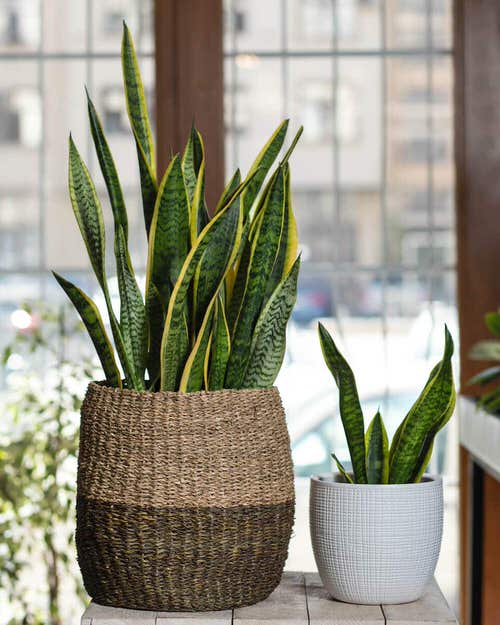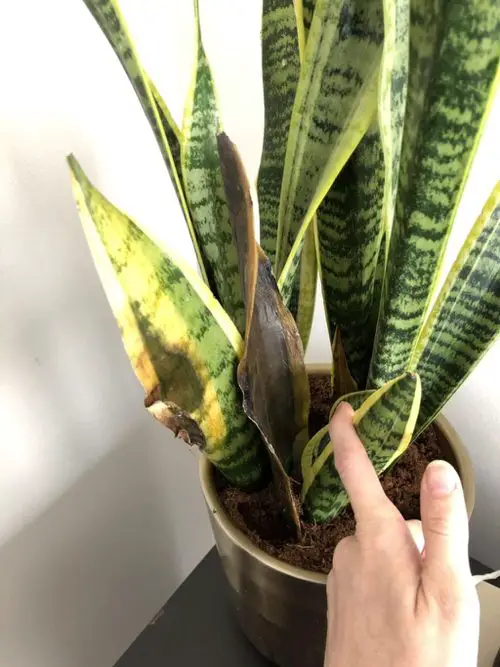Worried why your Snake Plant Leaves Curling? Wondering what could be the reason behind it? Well, here’s all you need to know about to prevent it!

Snake Plant or Mother-in-law’s tongue looks best when its foliage is healthy and upright. If you notice your Snake Plant Leaves Curling, then we have all the information you need to ensure your plant stays erect and beautiful!
Here are the best snake plant varieties you can grow indoors
Why Are My Snake Plant Leaves Curling?
Often, when your plant is going through stress, its leaves curl inward or outward. This is a vital sign because it can tell you a lot about what your Snake Plant is going through.
1. Too Much Light
Exposure to direct sunlight for long hours can make the plant lose water rapidly, which causes the leaves to curl.
Remedy: Avoid keeping the plant in the harsh afternoon sun. Also, make sure that you are not keeping it near the heating vent.
2. Fungal Infections
If you notice the snake plant’s blades curling along with brown spots, then it may have a fungal infection.
Remedy: Cut the rotten ends of the foliage to reduce the infection from spreading. Avoid overwatering the plant, use filtered water, and keep it in bright, filtered light.
3. Too Much or Too Little Watering
If the plant is getting less water, the blades begin to curl, wrinkle, and turn brown on the edges. In case of overwatering, the blades will be droopy, feel soft and become yellow.
Remedy: Maintain a watering schedule. Insert your finger 1 or 2 inches into the topsoil every 3-4 days. If you feel it dry–it’s time to water your plant!
4. Pest Infestations
With Snake plants, it is usually thrips and mealybugs that can cause serious damage to the leaves.
Remedy: Use a strong jet of water and a neem oil solution to get rid of the pests organically. You can also spray with 70% isopropyl alcohol (mix one part water) on mealybug infestation, and they’ll be gone.
5. Too Much Fertilization
Snake plants are not heavy feeders, and excessive fertilization will result in curled leaves, brown tips, and damaged roots.
Remedy: Use a slow-releasing nitrogen-rich fertilizer according to the instructions on the label. Avoid feeding the plant every month.
6. Root Rot

Wet and soggy conditions can cause root rot, which ultimately results in droopy foliage. It can also cause the plant to die in the longer run.
Remedy: Use a well-draining potting mix. Also, make sure that the pot has enough drainage holes at the bottom to avoid waterlogging.
7. Transplanting Shock
If you have recently re-potted the plant, its roots will take some time to get used to the new pot. Curling leaves is the first sign of a transplant shock.
Remedy: After transplanting/re-potting, avoid keeping the plant in the sun and keep it in the shade. After 1-2 weeks, it will get used to the new pot and environment.
8. Temperature Stress
Extreme temperatures and too much fluctuation in the same can cause the leaves to curl. When the temperature is on the higher side, it also accelerates the transpiration process of the plant.
Remedy: If you live in a hot region, make sure that the plant remains in the shade and gets dappled light. If you live in a cold region and the temperature goes below 10°C/50°F outside, then bring the plant indoors and keep it in a warm spot.
9. Lack of Light

The location of your snake plant is very important. If your plant is not getting enough light, the leaves will look like they can’t support themselves, thin, lanky, and curled.
Remedy: Though the plant can tolerate low light, it is advisable to keep it where it can receive at least bright, indirect daylight. In search of light, snake plant leaves spread and grow longer, which is one of the symptoms.


